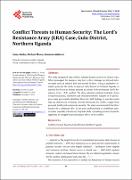| dc.contributor.author | Abaho, Anne | |
| dc.contributor.author | Mawa, Micheal | |
| dc.contributor.author | Asiimwe, Solomon | |
| dc.date.accessioned | 2024-04-05T07:11:56Z | |
| dc.date.available | 2024-04-05T07:11:56Z | |
| dc.date.issued | 2019-12-03 | |
| dc.identifier.issn | 2327-5960 (Online) | |
| dc.identifier.issn | 2327-5952 (Print) | |
| dc.identifier.uri | https://doi.org/10.4236/jss.2019.712006 | |
| dc.identifier.uri | http://hdl.handle.net/20.500.12280/3108 | |
| dc.description.abstract | The study recognised that conflicts threaten human security in various ways.
When prolonged, for example, they have a direct damage on physical infrastructure such as medical and educational facilities. Using a qualitative research approach, the study focused on Gulu district in Northern Uganda, to
unearth the threats to human security as a result of the protracted Lord’s Resistance Army (LRA) conflict. The data collection methods included: Focus
Group Discussions, Interviews and Document Review. Samples of 44 participants were purposively identified. From the field findings, it was discovered
that the dimensions of human security threatened by conflict ranged from
personal, health and community security. The study recommended that there
needs to be a deliberate effort in the post-conflict period to rehabilitate infrastructure especially schools and hospitals while counselling services should be
supported to mitigate the psychological effects of the conflict. | en_US |
| dc.language.iso | en | en_US |
| dc.publisher | Science Research Publishing | en_US |
| dc.relation.ispartofseries | Open Journal of Social Sciences;2019, 7, 64-85 | |
| dc.subject | Conflict | en_US |
| dc.subject | Human security | en_US |
| dc.subject | Gulu District | en_US |
| dc.subject | Northern Uganda | en_US |
| dc.title | Conflict threats to human security: the Lord’s Resistance Army (LRA) case, Gulu District, Northern Uganda | en_US |
| dc.type | Article | en_US |


